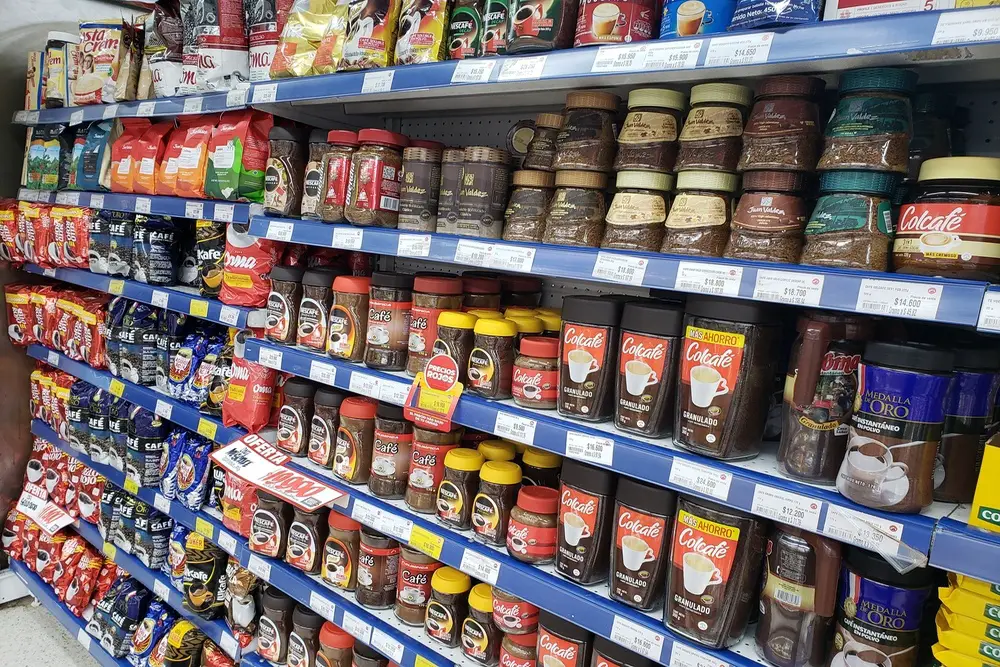Successful marketing comes partly from research and analysis, or from a deep understanding of the market and consumers. In the coffee business, a well-thought-out marketing strategy is crucial as it is a very competitive market. We don’t go into every detail of a marketing strategy below, but we do provide a good overview and some tips.
Table of Contents
Basics of coffee marketing
A marketing strategy should always be derived from a corporate strategy, its mission and vision. Although marketing and sales are a key aspect of any business, these strategies are not at the top of the hierarchy.
To have a goal
Defining goals in a company is not a difficult task right away. However, the more you go into depth, the more problems come to light.
Certain principles should be followed when setting goals:
- What is the deadline for the goal? (Long term, medium term or short term)
- Is the goal specific? (Sales increase by X% in Y time)
- Is the goal measurable? (How and with which method can I measure. Qualitative or quantitative goal)
- Is the goal realistic? (For example, offering coffee on the moon is currently unrealistic)
- Control deadlines and sub-goals? (Determination of control intervals and definition of sub-goals)
- Cannibalizing targets? (Fast growth and highest staff satisfaction)
As you can see, the deeper we delve into the subject, the more points are added. For an entrepreneur, however, goals are usually also intuitive. Unlike in academic teaching, small and micro-enterprises do not have departments for all strategy management. It is therefore utopian to expect such companies to deal with the topic very deeply and constantly, for which the resources are simply lacking.
Nevertheless, the strategy and the goals should not be completely disregarded.
Here is a selection of goals to better illustrate the topic:
- Increase sales by 5% over the next 12 months
- Increase marketing budget by 10% in the next fiscal year
- Reducing customer complaints by 2% over the next 6 months
- Increase profit margin by 3% next quarter
- Opening of another store in the next 5 years
Know your audience
Another important aspect is to know your customers and potential customers. There are different ways. Among other possible methods, one can either proceed empirically or also study market analyses.
Assessment of basic demographics
Customer data is the basis for successful marketing. It is important that you know who your customers are and how they behave. Many managers in the food and beverage industry do not know the average age of their customers. They also don’t know if the majority of their customers are male or female.
Without real customer data, it is not possible to generate the right messages and target them to specific customer groups. If you run a coffee shop in Japan and the average age of your customers is 70 years old, then the marketing efforts will be different to a shop in Colombia where the average age of customers is 25 years old.
Find out what your audience wants
You know your target group. Now you have to find out what this target group wants. Part of marketing is understanding the needs of potential customers.
Introduce marketing strategy for coffee
In coffee marketing, there is a specific order of tasks that requires the following.
A strong brand essence
This is the essence of the brand. Why start your coffee business? What was the moment that inspired you? What is the deep passion or mission?
Why should you tell the story of your coffee brand?
People love stories. Stories are a way to connect customers to a brand’s story, and emotions are a powerful selling factor. Remember Apple’s customers, who sometimes queued in front of the retail stores days before the launch of a new mobile phone. 55% of customers who like a brand story are more likely to make a purchase. 44% will tell someone the story and recommend the brand, and 15% will buy immediately.
Components of a coffee brand story
Here are a few approaches to mentioning in the story:
- Where does your coffee come from?
- Who grows your coffee and how does it get from there to your company?
- Who are the faces behind your brand?
- Why are you doing what you are doing?
Be human
Stories are uniquely human. Imagine telling your story to a friend or group of friends in a coffee shop. Chances are, that personal tone will resonate with your audience, too.
Connection on an emotional level
Emotions are the key to a successful story. People want to feel something, be it joy, sadness, empathy, laughter, anger, whatever is relevant. Put aside the old, sterile corporate tone and think about the emotion behind your narrative.
Get to the point
People are busy, have little time and want information to be presented in a nutshell. Many will only read the first few paragraphs of a text and will not invest more than 30 seconds. Therefore, short and clear information is important.
Marketing strategies and media
There are a variety of ways a marketing strategy can be implemented. Today the easiest way is to use digital media. As a layman, however, you should refrain from being present in all digital media at the same time. Also, one should not blindly trust a marketing agency. Before you want to implement the marketing strategy, invest time and learn the basics about the possible digital channels.
Online ratings and reviews
There are a variety of platforms where reviews can be left. Facebook and Google as well as their own website are just a few of them. However, as we learned from Amazon, there is also a big deal of cheating with reviews. However, the normal consumer is not aware of this. However, I urge caution. I think sooner or later regulation will take effect here and fines will be imposed. This applies above all to reviews on your own platforms, such as your own website.
However, online reviews are a powerful tool to attract potential customers. Encourage customers to write reviews and reply to them if possible. Good ratings can have a strong influence on a purchase decision.
Social media
For many businesses, the easiest and cheapest strategy leads to social media. This is also about creating brand value and awareness.
A word of warning here too. The days of organic growth on Instagram and Facebook are long gone. Before investing time, energy, and money in a medium, research that medium. The millions of Instagram accounts with no growth and no user participation is a good example of what will certainly not work.
If you have no idea about social media, learn it first!
Why should you use social media for your coffee business?
There are different strategies to use social media for yourself. You can run a Facebook or Instagram page and just be present in the market. I’m comparing this to an entry in the phone book (For those who remember what this was).
You can then provide the most important information and also convey some impressions by means of photos and/or videos. This is a passive strategy.
There are more platforms for a passive strategy, find out.
You can also launch campaigns via social media. You then pay money to Facebook, for example, and advertising is then actively shown to a defined target audience. Again, learn the principles yourself first.
Email Marketing
Gathering emails either in a physical location or on the website and sending out regular emails can lead to an increase in sales. You can thus form a customer base that identifies with the brand and consumes it regularly.
Content marketing for coffee
Content marketing is a fairly broad term that encompasses using content to promote your brand.
As you will see, this is exactly the strategy we use on this website. Also called SEO (Search Engine Optimization), the publication of content leads to visitors, who in turn can convert to consumers.
Coffee blog
This is a strategy that will require a lot of time from you in particular. Write down valuable information about coffee and publish these blogs on your website. This strategy targets organic visitors. This means that you don’t pay extra to advertise potential customers, but you attract them with attractive content.
However, this is also a lengthy and expensive strategy.
Coffee Podcasts
Podcasting is a booming industry. Some podcasters are celebrities these days and make millions. However, Nichen podcasts attract a very specific audience and can offer great support to a brand.
Paid Advertising
Paid advertising can be applied in both digital and traditional media. You can also put up a poster at a bus stop. Despite the boom in digital media, one should not despise traditional advertising channels.
No matter which path you choose, however, without a good strategy and the right messages, paid advertising will not achieve the goals set.
Innovation with new coffee products
Innovations are not only sales drivers in the world of coffee but in all industries. Nestle has shown in recent years that coffee capsules can make billions. Although I personally don’t like coffee capsules and the mountains of waste they produce give me nightmares, it’s a marketing success better than the textbook.
However, not all companies have Nestle’s resources. However, innovation does not only depend on the budget.
Is it risky to be innovative?
Innovation is partly a gamble. Sometimes you start a fad, but in most cases, nothing happens. So here are a few tips for an innovation strategy:
- Start small: the higher the bet, the more you can lose. There’s nothing wrong with starting small and growing.
- Start with trial and error: once you have your eye on a product, try it. Test it with your friends and family first, and if they respond positively, start trials with small groups of customers.
- Motivation: No master has fallen from the sky yet. All stories of quick success are either made up or statistical outliers. Discipline is your best ally for future success.
Merchandising your brand
Merchandising is a strategy that can be used very well by already established companies. There are brands such as Polo (polo shirts) whose core products are actually nothing more than merchandising. The logo and the brand are in the foreground and every customer is a brand ambassador.
However, we don’t want to start straight away in the premier class. If you can already sell mugs with the logo or brand name in a coffee shop, that’s already a great start.
Conclusions
Marketing and sales are among the most important topics and activities in a company. Don’t be afraid to read a few books to deepen your understanding of the subject. YouTube also offers great information today.
Before spending any money or using any other resources, you should understand the issues discussed above. Don’t hire an agency without understanding what a campaign really needs to do and what it needs to achieve.
Goal setting and target measurement are fundamental!



